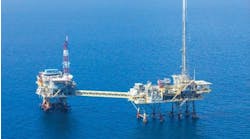Offshore staff
HOUSTON – StormGeo, a provider of decision support services and products for weather-sensitive operations, unveiled two new services at the recent Offshore Technology Conference in Houston.
OceanWatch is designed to provide continuous, real-time, site-specific monitoring and forecasting of ocean conditions and currents. As part of the package StormGeo supplies, installs and maintains acoustic doppler current profilers (ADCPs) which measure water current velocities over a depth range using a technique similar to sonar.
The company can deploy at least one ADCP at each site in advance of the start of a project.
StormGeo processes and analyzes the information, providing an overview of the ocean currents and other environmental characteristics locally.
Real-time current monitoring generates charts and graphs of local current predictions, giving online access where required to the sites’ physical environments. This data can be shared with project partners and government authorities to demonstrate compliance with regulations or for assistance in emergency circumstances.
StormGeo clients already using the service include various drilling contractors currently operating in the North Sea and offshore Patagonia in Argentina.
SpillWatch uses various models, simulation tools and sensors to track and predict the dispersion and effects of oil spills.
The oil spill trajectory model has been developed in cooperation with Norway’s SINTEF institute and is based on the OSCAR model. Users can choose between different scenarios based on oil type, surface or subsea blow out at different rates.
According to StormGeo’s senior business development manager Bjorn Erik Sampson, “SpillWatch continuously runs a pre-defined likely scenario. When you bundle this with operational data, you can decide more quickly how to react.” It can be tailored to incorporate weather buoys and drifters – the latter can be deployed in an actual spill to provide information on how it is moving.”
The two services are modular and complement each other, the company stresses.
05/11/2015


